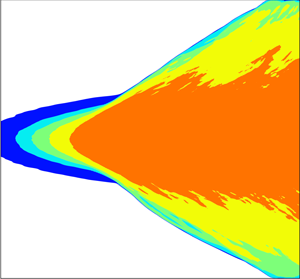Article contents
Parametrization of irreversible diapycnal diffusivity in salt-fingering turbulence using DNS
Published online by Cambridge University Press: 25 January 2021
Abstract

We employ direct numerical simulations of salt fingering engendered turbulent mixing to derive a parameterization scheme for the representation of this physical process in low-resolution ocean models and compare the results with those previously suggested on empirical grounds. In this analysis we differentiate between the reversible and irreversible contributions to diapycnal diffusivity associated with the turbulence generated by this mechanism. The necessity of such a distinction has been clearly recognized in connection with shear-driven density stratified turbulence processes: only irreversible processes can contribute to the effective turbulent diapycnal diffusivity. We expand the formalism herein to the more complicated salt-fingering case as a first step towards analysis of the general case. The irreversible fluxes are determined in the case of salt fingering related turbulence by examining high-resolution direct numerical simulation (DNS)-derived turbulence data sets based upon two different models: namely the ‘unbounded gradient model’ and the ‘interface model’ with depth-dependent gradients of temperature and salinity. By fitting the irreversible diapycnal fluxes in the unbounded gradient model (for equilibrium states) as a function of density ratio (the governing non-dimensional parameter), we derive a functional form that can be used as a basis for a next generation salt-fingering parametrization scheme. By applying this scheme to the interface model, we demonstrate that the local fluxes predicted agree well with those obtained from the numerical simulations based upon this more complex model. We compare this new DNS-derived turbulence parameterization with those that have been derived empirically.
Information
- Type
- JFM Papers
- Information
- Copyright
- © The Author(s), 2021. Published by Cambridge University Press
References
REFERENCES
- 11
- Cited by


